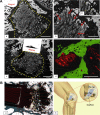Magnetic hydroxyapatite: a promising multifunctional platform for nanomedicine application
- PMID: 29200851
- PMCID: PMC5702531
- DOI: 10.2147/IJN.S147355
Magnetic hydroxyapatite: a promising multifunctional platform for nanomedicine application
Abstract
In this review, specific attention is paid to the development of nanostructured magnetic hydroxyapatite (MHAp) and its potential application in controlled drug/gene delivery, tissue engineering, magnetic hyperthermia treatment, and the development of contrast agents for magnetic resonance imaging. Both magnetite and hydroxyapatite materials have excellent prospects in nanomedicine with multifunctional therapeutic approaches. To date, many research articles have focused on biomedical applications of nanomaterials because of which it is very difficult to focus on any particular type of nanomaterial. This study is possibly the first effort to emphasize on the comprehensive assessment of MHAp nanostructures for biomedical applications supported with very recent experimental studies. From basic concepts to the real-life applications, the relevant characteristics of magnetic biomaterials are patented which are briefly discussed. The potential therapeutic and diagnostic ability of MHAp-nanostructured materials make them an ideal platform for future nanomedicine. We hope that this advanced review will provide a better understanding of MHAp and its important features to utilize it as a promising material for multifunctional biomedical applications.
Keywords: drug delivery; hydroxyapatite; hyperthermia; iron oxide; tissue engineering.
Conflict of interest statement
Disclosure The authors declare no conflicts of interest in this work.
Figures











Similar articles
-
Multifunctional magnetic nanostructured hardystonite scaffold for hyperthermia, drug delivery and tissue engineering applications.Mater Sci Eng C Mater Biol Appl. 2017 Jan 1;70(Pt 1):21-31. doi: 10.1016/j.msec.2016.08.060. Epub 2016 Aug 24. Mater Sci Eng C Mater Biol Appl. 2017. PMID: 27770883
-
Magnetic nanoparticles in nanomedicine: a review of recent advances.Nanotechnology. 2019 Dec 13;30(50):502003. doi: 10.1088/1361-6528/ab4241. Epub 2019 Sep 6. Nanotechnology. 2019. PMID: 31491782 Review.
-
Biomedical Applications of Advanced Multifunctional Magnetic Nanoparticles.J Nanosci Nanotechnol. 2015 Dec;15(12):10091-107. doi: 10.1166/jnn.2015.11691. J Nanosci Nanotechnol. 2015. PMID: 26682455 Review.
-
Shape Anisotropic Iron Oxide-Based Magnetic Nanoparticles: Synthesis and Biomedical Applications.Int J Mol Sci. 2020 Apr 1;21(7):2455. doi: 10.3390/ijms21072455. Int J Mol Sci. 2020. PMID: 32244817 Free PMC article. Review.
-
Magnetic nanoparticle-based approaches to locally target therapy and enhance tissue regeneration in vivo.Nanomedicine (Lond). 2012 Sep;7(9):1425-42. doi: 10.2217/nnm.12.109. Nanomedicine (Lond). 2012. PMID: 22994959 Free PMC article. Review.
Cited by
-
Bio-Inspired Nanomaterials for Micro/Nanodevices: A New Era in Biomedical Applications.Micromachines (Basel). 2023 Sep 18;14(9):1786. doi: 10.3390/mi14091786. Micromachines (Basel). 2023. PMID: 37763949 Free PMC article. Review.
-
Biomimetic Nanomaterials: Diversity, Technology, and Biomedical Applications.Nanomaterials (Basel). 2022 Jul 20;12(14):2485. doi: 10.3390/nano12142485. Nanomaterials (Basel). 2022. PMID: 35889709 Free PMC article. Review.
-
Iron in Hydroxyapatite: Interstitial or Substitution Sites?Nanomaterials (Basel). 2021 Nov 5;11(11):2978. doi: 10.3390/nano11112978. Nanomaterials (Basel). 2021. PMID: 34835742 Free PMC article.
-
Biomaterial-assisted tumor therapy: A brief review of hydroxyapatite nanoparticles and its composites used in bone tumors therapy.Front Bioeng Biotechnol. 2023 Apr 7;11:1167474. doi: 10.3389/fbioe.2023.1167474. eCollection 2023. Front Bioeng Biotechnol. 2023. PMID: 37091350 Free PMC article. Review.
-
One-pot hydrothermal synthesis of a magnetic hydroxyapatite nanocomposite for MR imaging and pH-Sensitive drug delivery applications.Heliyon. 2020 Sep 19;6(9):e04928. doi: 10.1016/j.heliyon.2020.e04928. eCollection 2020 Sep. Heliyon. 2020. PMID: 32995618 Free PMC article.
References
-
- Freeman MW, Arrott A, Watson HL. Magnetism in medicine. J Appl Phys. 1960;31:404S–405S.
-
- Pankhurst QA, Connolly J, Jones SK, Dobson J. Applications of magnetic nanoparticles in biomedicine. J Phys D Appl Phys. 2003;36:R167–R181.
-
- Polyak B, Friedman G. Magnetic targeting for site-specific drug delivery: applications and clinical potential. Expert Opin Drug Deliv. 2009;6(1):53–70. - PubMed
-
- Trandafir DL, Mirestean C, Turcu RVF, Frentiu B, Eniu D, Simon S. Structural characterization of nanostructured hydroxyapatite-iron oxide composites. Ceram Int. 2014;40:11071–11078.
-
- Tampieri A, D’Alessandro T, Sandri M, et al. Intrinsic magnetism and hyperthermia in bioactive Fe-doped hydroxyapatite. Acta Biomater. 2012;8(2):843–851. - PubMed
Publication types
MeSH terms
Substances
LinkOut - more resources
Full Text Sources
Other Literature Sources

